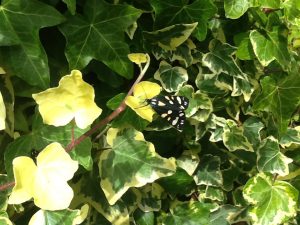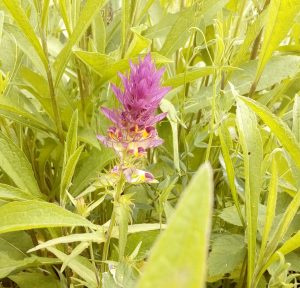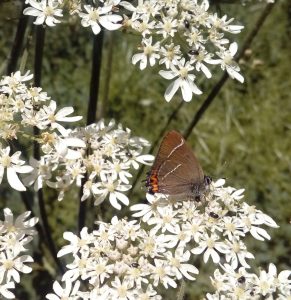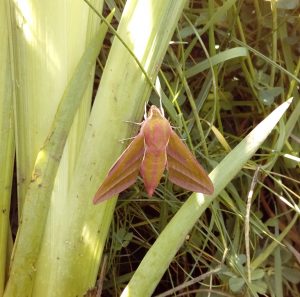Spring and summer wildlife highlights
by Ian Short
For me, the pleasure of seeing wildlife depends heavily on the setting, location, and health of the species. As an example, every so often at College Lake in Tring there turns up an isolated wading bird that should really be with others of its kind in North or South America. Probably it has been blown off course while migrating. It has little chance of ever seeing its fellow species again, and it has a high chance of perishing. Certainly not a wildlife highlight for me; I feel sorry for the lost birds.
For another example, we fairly often see barn owls at wildlife shows. It’s interesting to look at them close up, however, seeing them in captivity doesn’t compare to seeing them alive in the wild. Once while E and I were walking in Parkgate near our house at dusk, still daylight, a barn owl flew overhead, coming close by. Presumably it had left its daytime roosting place and was heading to the marsh for hunting. That was our best sighting of a barn owl: clear view, no car headlights involved, and the owl doing what it should be doing in its natural habitat.
There you have the groundwork for my list of summer wildlife highlights, the top twelve, going from lowest to highest. The list is by no means definitive, or carefully thought out; it’s just what I happen to remember now, written much later.
12. Cinnabar moths appearing out of nowhere
Last year our small back garden had a number of ragwort plants, all covered in cinnabar moth caterpillars. This year we had very few ragworts, but we did have cinnabar moths appearing every few hours on bright sunny days in spring. Presumably they had spent the winter in their pupal stage just underground and were emerging with the heat. They would hang around in our back garden for a bit and then venture off.
11. Military orchids at Homefield Wood
Homefield Wood has a great patch for orchids, with military orchids the stars of the show.
10. Black hairstreaks at Salcey Forest
It was an incredible year for butterflies. We attended a Butterfly Conservation walk at Salcey Forest and a wealth of black hairstreaks greeted us, flitting around in the trees above. We saw plenty of other lepidoptera too, including wood white butterflies.
9. Dark green fritillaries at Sharpenhoe Clappers
Dark green fritillaries and six-spot burnet moths in their hundreds. There were moths emerging from blades of grass all over the field, we were surrounded by them. [Insert picture!]
8. Scarlet tiger moths while walking home from school
On one occasion in spring while walking home with the girls from school through the golf course we encountered several scarlet tiger moths flying about. What they were doing, I don’t know; they were just hanging out by some leylandii. The following day they were there again!
Whatever you do, don’t picture some idyllic countryside location – we live on the outskirts of Milton Keynes.
Here’s a shot of some scarlet tiger moths from our back garden from the year before.
7. Frogs and newts in our back garden pond
We have a tiny pond in our back garden. It is surrounded by rocks and overgrown pond-friendly plants. There is a large sprawling compost heap nearby. I spent a long time this summer watching frogs and newts together in the pond. The frogs are easier to photograph as they like to sit on the weeds sticking out above the surface.
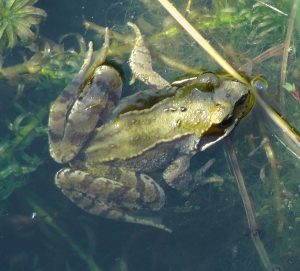
6. Common blue damselflies emerging
Our pond is also home to many common blue damselfly nymphs. On one day in spring I counted about twenty nymphs crawling up stalks of flag iris and other plants, ready to transform into damselfies. Here’s my best shot. [Poor quality will update.]
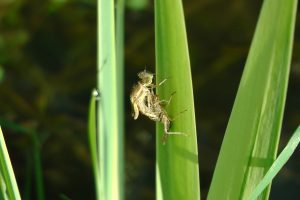
5. Slow worm at the end of our street
I was jogging to fetch the girls from school and this slow worm was wriggling around on the path into the golf course. I got a good view of it for 5 seconds. Rare to see them in the open like that. We do have grass snakes and some say even a few adders around here (I have my doubts about the latter).
4. Field cow wheat
E monitors the plant species on a patch of land for Plantlife. The highlight of this patch is field cow wheat, an extremely rare flower, known only to grow in a few places in England. It was once common in certain spots in the South, but its long-term future is doubtful. (A housing estate is planned for the patch E monitors.)
It was living happily in E’s patch alongside a load of yellow rattle.
3. White letter hairstreak at the OU
I have no idea what this was doing at the OU, but there it is to cap an extraordinary spring and summer for butterflies.
2. Elephant hawk moth in the back garden
They aren’t rare, but they are awesome.
Must finish with my favourite…
1. Return of the swifts
The swifts were late to return this year, and I was worried. But they came, at last, a few weeks later than usual, and for three months of the summer in the skies above Woburn Sands, piecing through the traffic noise, was the screech of swifts.
